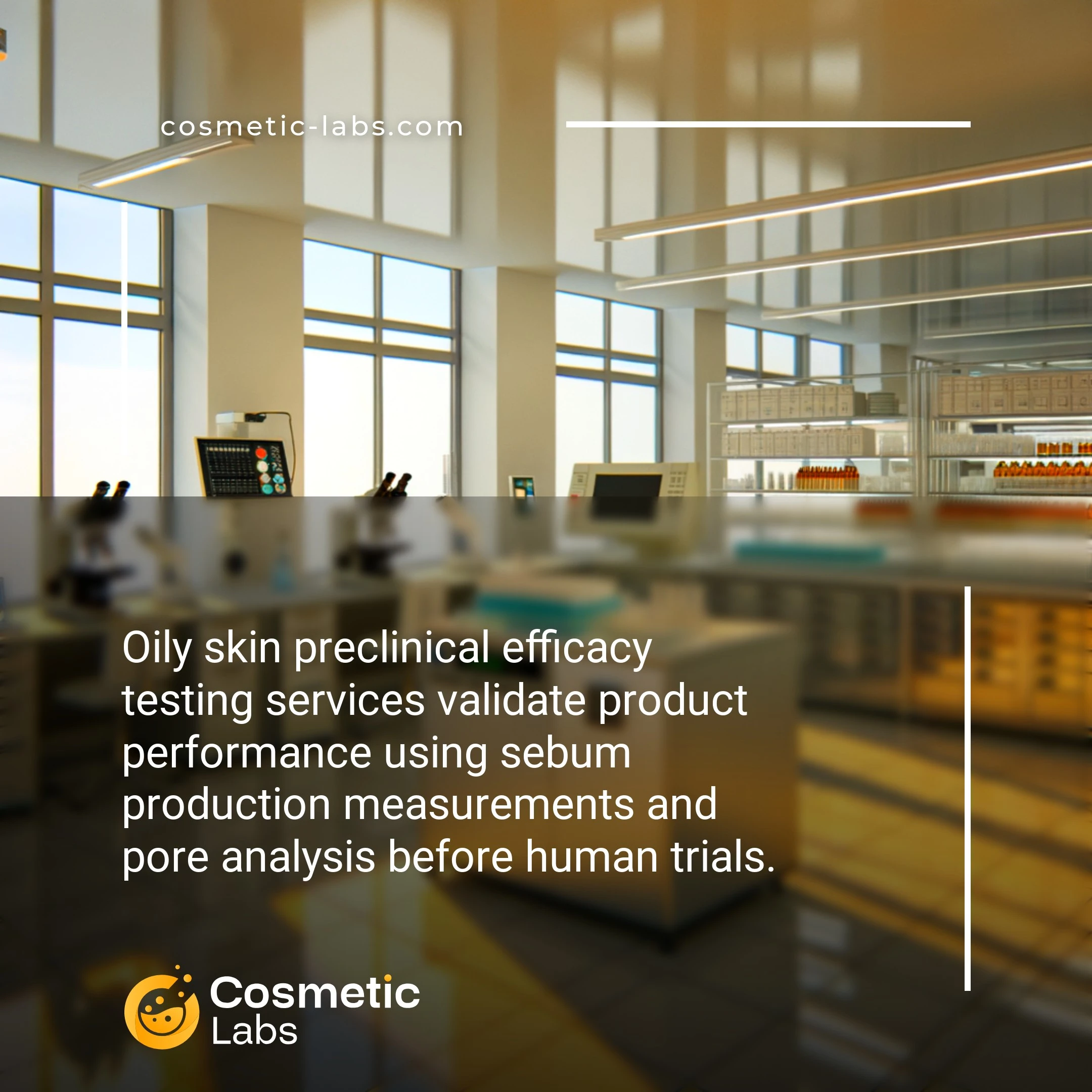Oily Skin Testing Services for Cosmetic Product Development

What is Oily skin efficacy testing?
Oily skin preclinical efficacy testing services validate your sebum-control formulations through controlled laboratory studies before human trials. Labs measure oil production reduction, pore appearance, and shine control using sebum tape analysis and digital imaging over 2-8 week protocols. What many brands don’t realize is that testing oily skin products requires specialized environmental chambers that replicate high-humidity conditions to accurately simulate real-world performance challenges.
Why do you need this service?
Cosmetic labs perform sebum production measurement and pore size analysis to validate your oil-control formulations before market launch. These in-vitro assessments help brands prove their mattifying serums reduce shine by 40-60% within 4 hours, while comedogenicity testing confirms products won’t clog pores. Labs also conduct skin barrier function studies that demonstrate how your lightweight moisturizers maintain hydration without triggering excess oil production, giving you the clinical data needed for regulatory submissions and marketing claims.
Who provides Oily skin efficacy testing services?
All cosmetic labs providing Oily skin efficacy testing services
There is no company providing these services at the moment.
Oily Skin Preclinical Efficacy Testing Services
Labs on our platform offer specialized oily skin preclinical efficacy testing to validate your sebum control formulations before market launch. These services measure oil production reduction, pore appearance, and shine control across diverse skin types through standardized protocols.
Sebum Production Analysis
Testing facilities use sebum tape analysis and digital imaging to quantify oil production changes over 2-12 week periods. Labs measure baseline sebum levels, then track reductions following product application. Most facilities test on 20-30 volunteers with oily skin types to establish statistical significance.
Key measurements include:
- Sebum production rates (μg/cm²/hour)
- Pore size reduction percentages
- Shine reduction scores using standardized lighting
- Oil blotting paper absorption rates
Mattifying Effect Validation
Labs evaluate your product’s ability to control shine and maintain a matte finish throughout the day. Testing protocols include photographic documentation at specific intervals (2, 4, 6, and 8 hours post-application) under controlled lighting conditions. Facilities also measure oil breakthrough time and reapplication frequency needs.
Standard testing includes pH compatibility checks, since oily skin formulations often target specific pH ranges. Labs verify your product maintains effectiveness across different environmental conditions like humidity and temperature variations.
Ready to validate your oily skin formulation? Connect with experienced testing labs on our platform to discuss your specific efficacy requirements and timeline.
7 subcategories of Oily skin efficacy testing services
There are no results matching your search
Practical Applications of Oily Skin Preclinical Efficacy Testing
Cosmetic labs use oily skin preclinical efficacy testing applications to validate sebum control claims, optimize formulations, and generate data for regulatory submissions before launching products targeting excess oil production.
Sebum Regulation Product Development
Labs measure sebum production using sebotapes and corneometers to quantify oil reduction in test subjects. These protocols track sebaceous gland activity over 2-4 week periods, documenting percentage changes in surface lipids. Product developers use this data to adjust active ingredient concentrations and delivery systems.
Testing typically involves split-face studies where one side receives the test product while the other serves as control. Labs document improvements ranging from 15-40% sebum reduction, depending on formulation strength and testing duration.
Pore Appearance and Shine Assessment
Digital imaging systems capture pore visibility and skin shine under standardized lighting conditions. Labs use specialized cameras with polarized filters to measure surface reflection and pore diameter changes. These visual assessments complement biochemical sebum measurements.
Participants undergo weekly photography sessions, allowing labs to track gradual improvements in skin texture. Results show measurable pore size reductions of 10-25% and shine reduction scores that correlate with consumer perception studies.
| Testing Method | Measurement Tool | Timeline | Key Metrics |
|---|---|---|---|
| Sebum Production | Sebotape/Corneometer | 2-4 weeks | % Oil reduction |
| Pore Visibility | Digital imaging | 4-6 weeks | Pore diameter change |
| Surface Shine | Polarized photography | 2-3 weeks | Reflection intensity |
| Skin Texture | 3D surface analysis | 4-8 weeks | Roughness parameters |
Ready to validate your oily skin formulations with precise efficacy data? Contact cosmetic labs on our platform to discuss your specific testing requirements and regulatory goals.

